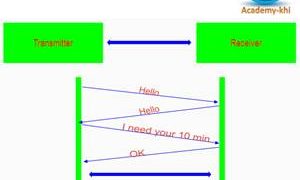Dailymotion
Ethernet Introduction
Ethernet is the name of LAN standard defined by IEEE 802.3. It was basically introduced as a LAN technology.With the introduction of Gb Ethernet. Now It is MAN and WAN standard. It is data link layer Protocol.
- Shared access network technology
- Link layer technology
- Use CSMA/CD
- Backoff Algorithm
- Low Cost
- Easy to implement
- Easy to manage
History
Aloha
Developed by Bob Metcalfe and others at Xerox PARC in mid-1970s.
If receive Ack then communication success otherwise send again. It was designed for 3Mb/s.
Slotted Aloha
Delay of transmission of collided packet for a random time.
DIX Ethernet in 1980
DIX was developed by three organizations Digital, Intel, and xerox. In 1980 DIX Ethernet v.1 was introduced with the speed of 10Mb/s.
Project 802 of IEEE
In 1985 IEEE started a project 802. Named for the year and month (’80 Feb). Its goal was to set standards to establish communication between devices. It defines a family of protocols at Data link and physical layers. Ethernet10BaseT was introduced. Manchester encoding.
- 802.1–overview of project 802, including higher layers and internetworking
- 802.2-logical link control (LLC)
- 802.3- Ethernet – carrier sense multiple access with collision detect (CSMA/CD.
- 802.4-token bus
- 802.5-token Ring
- 802.6-metropolitan area network
- 802.7-broadband technology
- 802.8-optical fiber technology
- 802.9-voice/data integration on LANs
- 802.10-standard for interoperable LAN security
IEEE 802.3 Data Link Layer = LLC + MAC
In ethernet architecture, data link layer is divided into two parts
-
LLC (Logical link control)
- Upper layer communication
- Flow control
- Link establishment and termination
- Framing
- Interconnectivity between data link layer of different LAN.
-
MAC(Media access control)
- Error Checking
- Media access control
- Frame transmission and its recovery in case of failure.
- Interaction with physical layer
IEEE 802.3 CSMA/CD
CSMA = First listen then speak.
CD= While speaking, listen also. If someone speaking, stop.
Medium is idle, transmit.
Medium busy, wait for free and then transmit immediately.
If collision detected during transmission, Transmit a jam signal of high voltage. It is just like “Stop I m talking at this time”.
Backoff Algorithm
Wait for sometime. Reattempt if problem not resolved. If continue problem then go home and come again.
Ethernet Frame.
Minimum packet size is 64 bytes.
18 header bytes and 46 data bytes.
If less than 46 bytes to send, then add dummy bits to increase the length to 46 bytes.
Maximum packet size 1518 bytes
Preamble:
7 bytes with pattern 101010……………1010101010 used for clock synchronization.
eighth byte is start of frame (10101011)
Addresses:
6 bytes (Source and Destination MAC address).
Type/length:
Indicates the type of the Network layer protocol.mostly IP but may be Novell IPX and AppleTalk.
Allow multiple network layer protocols to be supported on a single machine (multiplexing).
Identifies the length of data field.
CRC:
It checks errors at receiver, if detected, frame discard.
Data:
It is sequence of bits less than or equal to 1500. carries data from the upper-layer protocols.
Pad:
Zeros are added to the data field to make the minimum data length = 46 bytes.
Ethernet media.
Data rate (10, 100, 1,000).
10, 100, 1,000Mbps.
Signaling method (base, broad).
Baseband.
Broadband.
Cabling (2, 5, T, F, S, L).
5 – Thick coax (original Ethernet cabling).
F – Optical fiber.
S – Short wave laser over multimode fiber.
L – Long wave laser over single mode fiber.
Twisted pair
10-BaseT twisted pair standard
Coaxial cable
10Base2 Thin coaxial standard.
10Base5 Thick coaxial standard
Fiber Optic
10Base-FL
100Base-Sx
100Base-Lx




